Repositorio de Artículos | Congreso Virtual Internacional de Psiquiatría, Psicología y Salud Mental (Interpsiquis) | V Edición | 2004
La realidad virtual en el tratamiento de pacientes con lesiones frontales.
Autor/autores: S. Palacios
RESUMEN
La rehabilitación cognitiva es descrita como la aplicación de un conjunto de procedimientos de cara a mejorar el desarrollo de habilidades y estrategias necesarias para superar déficit cognitivos. Las herramientas computacionales pueden ser provechosamente utilizadas en la evaluación y rehabilitación de las funciones cognitivas y ejecutivas. En particular, la Realidad Virtual podría jugar un papel clave en la rehabilitación de funciones psicológicas gracias a la creación de ambientes artificiales donde es posible llevar a cabo tareas muy similares a las que se experimentan en contextos reales.
Además del análisis de las principales características y encuadre de la rehabilitación cognitiva basada en la Realidad Virtual y el ordenador personal, esta comunicación tiene como objetivo principal describir a) la justificación teórica del uso de la Realidad Virtual en este campo y b) algunas herramientas de Realidad Virtual (V-Store, V-Tol, V-Wcst) usadas con una categoría concreta de disfunción, (Síndrome Frontal), representativo de los pacientes con lesiones en el lóbulo frontal y otras afecciones neurológicas. En particular, se hace la descripción de V-Store.
Palabras clave: realidad virtual
Tipo de trabajo: Conferencia
Área temática: Tratamientos .
La realidad virtual en el tratamiento de pacientes con lesiones frontales.
(Virtual reality in the cognitive rehabilitation of frontal patients. )
G. Castelnuovo*; S. Palacios**; C. Lo Priore***.
* Department of Psychology, Catholic University of Milan
** Departamento de psicología Evolutiva y de la Educación de la Universidad del País Vasco
*** Department of Psychology, University of Padua.
Resumen
La rehabilitación cognitiva es descrita como la aplicación de un conjunto de procedimientos de cara a mejorar el desarrollo de habilidades y estrategias necesarias para superar déficit cognitivos. Las herramientas computacionales pueden ser provechosamente utilizadas en la evaluación y rehabilitación de las funciones cognitivas y ejecutivas. En particular, la Realidad Virtual podría jugar un papel clave en la rehabilitación de funciones psicológicas gracias a la creación de ambientes artificiales donde es posible llevar a cabo tareas muy similares a las que se experimentan en contextos reales. Además del análisis de las principales características y encuadre de la rehabilitación cognitiva basada en la Realidad Virtual y el ordenador personal, esta comunicación tiene como objetivo principal describir a) la justificación teórica del uso de la Realidad Virtual en este campo y b) algunas herramientas de Realidad Virtual (V-Store, V-Tol, V-Wcst) usadas con una categoría concreta de disfunción, (Síndrome Frontal), representativo de los pacientes con lesiones en el lóbulo frontal y otras afecciones neurológicas. En particular, se hace la descripción de V-Store.
Abstract
Cognitive rehabilitation is represented by the application of a lot of procedures in order to enhance development of skills and strategies necessary to overcome cognitive deficits. Computer-based tools can be fruitfully used in the assessment and rehabilitation of cognitive and executive functions. In particular Virtual Reality could play a key role in the rehabilitation of psychological functions due to a creation of synthetic environments where it is possible to carry on tasks very similar to the ones experienced in real contexts. After an analysis of the main characteristics and open issues of the PC and VR based cognitive rehabilitation, the major aim of this paper is to describe: a) the rationale for the use of Virtual Reality in this field and b) some VR tools (V-Store, V-Tol, V-Wcst) used with a particular category of dysfunction, the Dysexecutive Syndrome, typical of the patients with frontal lobe injuries and other neurological diseases. In particular the description of V-Store is provided.
The use of Virtual Reality in the cognitive rehabilitation
Among the different computer-based technologies, Virtual Reality plays a key role in the assessment and rehabilitation of psychological functions (Cunningham & Krishack, 1999), (Broeren, Bjorkdahl, Pascher, & Rydmark, 2002; Campbell, 2002; Gourlay, Lun, & Liya, 2000; Grealy & Heffernan, 2000; Jack et al. , 2001; Merians et al. , 2002; Piron, Cenni, Tonin, & Dam, 2001; Silva, 2002; Tarr & Warren, 2002; Zhang et al. , 2001). According to Tarr, Virtual reality (VR) has finally come of age for fruitful applications in neuroscience, cognitive science and psychology. The VR attractive is due to improvements in computer speed and quality of different tools (head-mounted displays, wide-area tracking systems, etc. )(Tarr & Warren, 2002).
Moreover VR is considered as the most advanced evolution of the relationship between man and computers (Vincelli, 2001). VR is different from other technologies because it offers to users the chance to experience psychological states of immersion and involvement (A. A. Rizzo, Wiederhold, & Buckwalter, 1998) due to the combination of hardware and software tools with particular interactive interfaces (such as head-mounted display and tracker). So one of the possible added values of Virtual Reality (with respect to traditional electronic systems of representation and interaction) seems to be the particular level of presence that subjects can experience in virtual environments (VEs). With the present and future development of technologies, synthetic environments will be able to re-create situations more and more similar to the ones we experiment in everyday life, therefore we can easily imagine that the possibility to feel presence in virtual environments will increase.
Virtual Reality is a technology used in many applications, from health care to arts, from e-learning to entertainment. Focusing on the health care field, VR finds a role in many areas such as psychotherapy (assessment and treatment of pathologies such as social phobias, eating disorders, sexual disorders, depression, autism, etc. ), cognitive rehabilitation (about memory, attention, spatial abilities and superior cognitive functions), motor rehabilitation (about paraplegia, parkinsonism and other disabilities). In particular, in the field of rehabilitation, the possibility to use new technologies has been studied (Gordon, Hibbard, & Kreutzer, 1989) and the potential of virtual reality based applications has been recognized (Pugnetti, 1998; A. A. Rizzo & J. G. Buckwalter, 1997).
According to Rizzo et al. (A. A. Rizzo et al. , 1998), it is necessary to carry on a realistic cost/benefit analysis to evaluate which is the added value of VR in different applications comparing with traditional approaches. A key question is does the objective that is being pursued require the expense and complexity of a VE approach, or can it be done as effectively and efficiently using simpler, less expensive, and currently more available means? (A. A. Rizzo et al. , 1998).
There are different issues to consider in order to evaluate the real costs and benefits of Virtual Reality in mental health applications. One of these important issues, in order to ensure high benefits in the use of VR, is represented by production of functional and useful environments. Traditionally, as indicated by Waterworth, VR designers typically aim at creating an engaging and convincing environment in which users feel present (Waterworth & Waterworth, 2001). The focus for VR developers seems to be “presence” and all the systems to improve it.
But the concept of presence is very complex because this psychological state is characterized by many factors and so a key issue becomes the choice of the presence factors that have to be considered in the use of VEs in mental health applications. Riva (2000) notes that the substantial challenge for the designers and users of VR is how to use immersive environments to support clinical practice (Riva, 2000). It becomes clear that a VE built for entertainment has to be different from a one use in psychotherapy or cognitive rehabilitation. So which are the core characteristics of a virtual environment in order to ensure a kind of presence that is functional and useful for mental health applications?
In Riva’s opinion two key characteristics of VR as a clinical oriented tool have to be the perceptual illusion of non-mediation and the sense of community: in mental health applications, reproducing physical aspects of virtual environments may be less important than the possibility of interaction that a VE could allow.
According to Riva, in clinical oriented environments “the criterion of the validity of presence does not consist of simply reproducing the conditions of physical presence but in constructing environments in which actors may function in an ecologically valid way” (p. 356, (Riva, 2000). Thus the level of presence, connected with the functional use of VEs in clinical applications, depends also on the level of interaction and possible interactivity (Riva, 2000).
Table 1. Possible issues to consider in designing Virtual Environments in clinical applications
Virtual Reality and rehabilitation of executive functions
In the field of disabilities, the category of cognitive dysfunctions can be classified making a distinction between the loss (partial or complete) of the basic instrumental cognitive functions (such as attention, memory, language, visual-spatial abilities, etc. ) and the loss of executive functions (also called central or control functions). These are generally referred to a group of behavioural skills that includes: the ability of planning a sequence of actions, the ability of maintaining attention in time, the ability of avoiding the interfering stimuli and using the feedback provided by others, the capability of coordinating more activities together at the same time, the cognitive and behavioural flexibility and the other abilities used to cope new situations and stimuli (Crawford, 1998).
Many terms have been used to define this syndrome: Disorders of Executive Functions; Dysexecutive Syndrome; Strategy Application Disorder (SAD); (Pre)Frontal Syndrome. Loss of executive functions is primarily a consequence of brain injury located in the prefrontal cortex area, but many different categories of subjects can be characterized by the same syndrome and by similar symptoms, with different levels of severity and various forms of resulting behaviour: patients suffering of different forms of dementia (Alzheimer Disease, Frontal or Frontal-Temporal Dementia, etc. ), patients with attention disorders and hyperactivity (i. e. ADD-H), subjects suffering of Schizophrenia.
Usually the problems related with cognitive disabilities are not evident: Thimble (1990) noted that the pathological conditions due to a frontal dysfunction, very often are not recognized in the clinical practice. This situation could happen, overall in the case of frontal lobe disease, because cognitive performance of subjects may not be significantly reduced and many traditional neuropsychological tests may fail to show significant dysfunctions in the patients’ responses (Damasio, 1995; Gourlay, Lun, Lee, & Tay, 2000). For example the traditional version of Wisconsin Card Sorting Test (WCST)(Heaton & Pendleton, 1981) has been usually considered a key measure in the diagnosis of frontal lobe dysfunction (Bornstein, 1986; Braff et al. , 1991; Drewe, 1974; Janowsky, Shimamura, Kritchevsky, & Squire, 1989; Milner, 1963, 1964), but recently Stuss et. al noted that “this view of the WCST as a specific measure of impairment in the frontal lobes has also been seriously questioned” (p. 388, (Stuss et al. , 2000).
As Damasio brilliantly pointed out, in the complex tasks of everyday life, the same patients may show great limits, decisional problems and inabilities connected with high levels of psychosocial suffering. It has been demonstrated that traditional tests of frontal lobes function may fail to document abnormality: this “diagnostic insensitivity” may cause problems between patients and health care services and can determine incapacity to predict the outcome of treatment.
Damasio’s famous patient Elliot not only had normal performances in the standard “frontal” cognitive tests, but in the lab assessment he showed normal responses to the proposed social situations, he planned strategies and he demonstrated to be able to evaluate correctly the consequences of actions in social situations. The same patient showed a severe decisional impairment and emotional deregulation in his real life environment, especially related to social situations. Elliot is described as the prototype of the hi-functioning frontal patient who experiments severe problems in his daily life.
From the point of view of cognitive rehabilitation, if we consider that the traditional protocols used in treatment are centered mainly to protect or recover the basic instrumental cognitive functions, we can understand why, in a clinical or lab setting, superior executive cognitive disabilities are today particularly hard to treat and thus receive a very reduced attention in relation to their dramatic real-life consequences.
From a theoretical point of view, we can try to explain the striking differences in performance and behaviour between lab and life as result of four main failures of the artificial situations to mimic reality: a) choices and decisions are only to be evoked, not to be really performed; b) lack of the normal cascade of events as actions and reactions; c) compressed temporal frame; d) situations are not really presented, but only described through language (Damasio, 1995). Our diagnostic and rehabilitative tools, built to be used in clinical or laboratory settings, fail their goal with executive functions because they cannot adequately reproduce real situations and the perception of the subject to be really present in them. Cognitive assessment and rehabilitation of executive functions faces us with the necessity to transfer our work in real life situations or, as a valid alternative, to be able to build artificial environments who can offer to the subject similar conditions and the same sense of presence.
The real value of VR in the treatment of dysexecutive syndrome
Cognitive rehabilitation has to allow patients to recover their planning, executing and controlling skills by implementing sequences of actions and complex behavioural patterns that are requested in everyday life (A. A. Rizzo & J. G. Buckwalter, 1997; A. A. Rizzo & J. G. Buckwalter, 1997): with these conditions, VR can be specifically indicated to reach this goal (Grealy, Johnson, & Rushton, 1999; A. A. Rizzo, 2000). Moreover VR allows to build realistic spatial and temporal scenarios that can be easily used to increase diagnostic sensitivity of standard paper&pencil tests (Pugnetti, 1995, 1998). For example, in the case of early recognition of Alzheimer’s disease, VR may be the most efficient method for a systematic screening of subjects (A. A. Rizzo et al. , 1998).
Due to the great flexibility of situations and tasks provided during the virtual sessions, considering both the time, difficulty, interest, and emotional engagement, this new technology allows, besides the diagnostic applications (Zhang et al. , 2001), to enhance the restorative and compensatory approaches in the rehabilitation process of cognitive functions inside the traditional clinical protocol.
In our opinion, in general cognitive rehabilitation, the added value of VR compared to the traditional treatment can be summarized according to the following points:
. customization on user’s needs: each virtual environment can be produced in a specific way focusing on the patient’s characteristics and demands;
. possibility to graduate: each virtual environment can be modified and enriched with more and more difficult and motivating stimuli and tasks. This last issue shall not be underestimated, because many subjects with cognitive dysfunctions show a low level of motivation and compliance about the traditional rehabilitation iter that is usually repetitive and not stimulating;
. high level of control: the possibility of controlling the rehabilitation process in its development is very high. This issue allows to professionals to monitor the level of affordability and complexity of the tasks that can be provided to patients;
. ecological validity: a virtual environment allows to stimulate in the subjects emotional and cognitive experiences like in the real life. So the tasks executed during the immersion in the VR can induce the patient to reproduce complex cognitive procedures (such as planning and organizing practical patterns of actions, attention shift, etc…) that are similar in all the aspects to the ones used in the situations of everyday life;
. costs reduction: rehabilitation with VR can be cheaper than the traditional one, mostly when it comes to the reconstruction of complex scenarios, also of very complex ones (such as presence of more persons in the same time, particular environmental conditions), which avoids the need to leave the rehabilitation office or building.
Nevertheless, when it comes to the specific needs of rehabilitation of dysexecutive symptoms and frontal lobe syndrome, the employment of virtual environments seems to have another fundamental advantage with respect to traditional non-immersive means.
According to Damasio (Damasio, 1995), see 1st par. ) diagnostic and rehabilitative tools used in labs and clinics often fail to assess and treat the frontal patients because they operate within artificial situations, which are far from reproducing the real situations. In this view, immersive virtual environments appear to be the best solution to make lab situations become closer to the natural setting in the subject’s perception.
For these reasons, in our work we decided not only to use and implement immersive virtual environments, but also to assess very carefully the key variables that support such choice: subjective sense of presence; qualitative evaluation of virtual experiences; usability level.
A possible VR-based tool for the rehabilitation of executive functions: the V-Store
In the “Paolo VI Centre of Cognitive Rehabilitation” at Casalnoceto (AL, Italy), the traditional protocol followed in the cognitive rehabilitation has been experimentally integrated with sessions of Virtual Reality.
V-STORE is a virtual environment that consists of a fruit store internal room: the subject (or more correctly his “avatar”, his representation within the virtual world) is set in front of a conveyor belt on which some baskets (from one to three) cross the room. The subjects’ task is to fill up the baskets with pieces of fruit that can be found in four shelves located along the other walls of the room.
At the beginning of each trial, a verbal command is communicated through a loudspeaker, located on the front wall, by which the subject is instructed about what to do: how to fill the baskets and with what kind of fruit. The task has to be completed accurately before the baskets run out of the room on the belt, or else the trial will be repeated from the beginning. It is possible to fix a maximum limit in how many “moves” the subject can execute to solve the trial, forcing him to follow the most efficient and quick strategy.
Figure 1. A screenshot of the first level of V-Store
The tasks are ordered according to their complexity, starting from very quick trials that need few fruit moves, up to trials that start with a long and verbally complex command and request special strategies in moving the available fruits from one basket to another. The trials are currently divided in six levels of ten tasks each.
Other elements which are present in the environment are a waste basket, the light switch and a wall telephone, located on the rear wall, through which the subject can receive supplemental orders that integrate the initial verbal command in the most difficult level. The subject can intervene on some additional commands, by which he can stop the belt, end the trial, freeze time.
The supervising examiner can introduce a series of distracting events which increase difficulty and are meant to generate time pressure: room light fainting or progressive dimming, telephone ring, belt speed modification. In these situations, the most interesting focus of performance and rehabilitation consists in the managing steps that the subject will operate and his strategic approach.
For each trial, the system records the following data about the subject’s performance for further analysis or research: accuracy, execution time, moves and strategical planning, and furthermore the managing steps taken to face distractors or difficulties, which often constitute the greatest limit for frontal patients.
Figure 2. A screenshot of the last level of V-Store (room lights dimmed)
Ongoing studies in “Paolo VI Centre of Cognitive Rehabilitation” aim at planning, developing and testing a rehabilitation protocol with virtual different virtual tools (see Table 2) for high-level cognitive dysfunctions that affect patients with brain injures, cerebral diseases, degenerative pathologies and in particular subjects who can be evaluated as “frontal patients” in scientific literature: we also suppose that the developed applications could be useful in a broad spectrum of rehabilitative opportunities.
Table 2. Synthetic description of the V-Store and other tools that ongoing studies are developing in “Paolo VI Centre of Cognitive Rehabilitation” at Casalnoceto (AL, Italy)
References
Bornstein, R. (1986). Contribution of various neuropsychological measures to detection of frontal lobe impairment. The International Journal of Clinical Neuropsychology, 8, 18-22.
Braff, D. , Heaton, R. K. , Kuck, J. , Cullum, M. , Moranville, J. , Grant, I. , et al. (1991). The generalized pattern of neuropsychological deficits in outpatients with chronic schizophrenia with heterogeneous Wisconsin Card Sorting Test results. Archives of General Psychology, 48, 891-898.
Broeren, J. , Bjorkdahl, A. , Pascher, R. , & Rydmark, M. (2002). Virtual reality and haptics as an assessment device in the postacute phase after stroke. Cyberpsychol Behav, 5(3), 207-211.
Campbell, M. (2002). The rehabilitation of brain injured children: the case for including physical exercise and virtual reality: a clinical perspective. Pediatr Rehabil, 5(1), 43-45.
Crawford, J. (1998). Assessment of attention and executive functions. Neuropsychological rehabilitation, 8.
Cunningham, D. , & Krishack, M. (1999). Virtual reality: a wholistic approach to rehabilitation. Stud Health Technol Inform, 62, 90-93.
Damasio, A. R. (1995). L'errore di Cartesio: Adelphi.
Drewe, E. (1974). The effect of type and area of brain lesion on Wisconsin Card Sorting Test performance. Cortex, 10, 159-170.
Gordon, W. A. , Hibbard, M. R. , & Kreutzer, J. S. (1989). Cognitive remediation: Issues in research and practice. Journal of Head trauma Rehabilitation, 4(3), 76-84.
Gourlay, D. , Lun, K. C. , Lee, Y. N. , & Tay, J. (2000). Virtual reality for relearning daily living skills. Int J Med Inf, 60(3), 255-261.
Gourlay, D. , Lun, K. C. , & Liya, G. (2000). Telemedicinal virtual reality for cognitive rehabilitation. Stud Health Technol Inform, 77, 1181-1186.
Grealy, M. A. , & Heffernan, D. (2000). The rehabilitation of brain injured children: the case for including physical exercise and virtual reality. Pediatr Rehabil, 4(2), 41-49.
Grealy, M. A. , Johnson, D. A. , & Rushton, S. K. (1999). Improving cognitive function after brain injury: the use of exercise and virtual reality. Arch Phys Med Rehabil, 80(6), 661-667.
Heaton, R. K. , & Pendleton, M. G. (1981). Use of Neuropsychological tests to predict adult patients' everyday functioning. J Consult Clin Psychol, 49(6), 807-821.
Jack, D. , Boian, R. , Merians, A. S. , Tremaine, M. , Burdea, G. C. , Adamovich, S. V. , et al. (2001). Virtual reality-enhanced stroke rehabilitation. IEEE Trans Neural Syst Rehabil Eng, 9(3), 308-318.
Janowsky, J. S. , Shimamura, A. P. , Kritchevsky, M. , & Squire, L. R. (1989). Cognitive impairment following frontal lobe damage and its relevance to human amnesia. Behavioural Neuroscience, 103, 548-560.
Merians, A. S. , Jack, D. , Boian, R. , Tremaine, M. , Burdea, G. C. , Adamovich, S. V. , et al. (2002). Virtual reality-augmented rehabilitation for patients following stroke. Phys Ther, 82(9), 898-915.
Milner, B. (1963). Effects of different brain lesions on card sorting: The role of the frontal lobes. Archives of Neurology, 9, 100-110.
Milner, B. (1964). Some effects of frontal lobectomy in man. In J. M. Warren & K. Akert (Eds. ), The frontal granular cortex and behaviour (pp. 313-334). New Jork: McGraw-Hill.
Piron, L. , Cenni, F. , Tonin, P. , & Dam, M. (2001). Virtual Reality as an assessment tool for arm motor deficits after brain lesions. Stud Health Technol Inform, 81, 386-392.
Pugnetti, L. e. a. (1995). Evaluation and retraining of adults' cognitive impairment: which role for virtual reality technology? Comput Biol Med, 25(2), 213-227.
Pugnetti, L. e. a. (1998). VR experience with neurological patients: basic cost/benefit issues. Stud Health Technol Inform, 58.
Riva, G. (2000). Design of clinically oriented virtual environments: a communicational approach. Cyberpsychol Behav, 3(3), 351-357.
Rizzo, A. A. (2000). Virtual Environment Applications in Clinical Neuropsychology. Paper presented at the Medicine meets Virtual Reality 2000.
Rizzo, A. A. , & Buckwalter, J. G. (1997). The status of virtual reality for the cognitive rehabilitation of persons with neurological disorders and acquired brain injury. Stud Health Technol Inform, 39, 22-33.
Rizzo, A. A. , & Buckwalter, J. G. (1997). Virtual reality and cognitive assessment and rehabilitation: the state of the art. Stud Health Technol Inform, 44, 123-145.
Rizzo, A. A. , Wiederhold, M. , & Buckwalter, J. G. (1998). Basic issues in the use of virtual environments for mental health applications. Stud Health Technol Inform, 58, 21-42.
Shallice, T. (1982). Specific impairments in planning. In Philosophical Transactions of the Royal Society (Vol. 298, pp. 199-209).
Silva, M. R. (2002). Virtual reality in Latin American clinical psychology and the VREPAR project. Virtual Reality Environments for Psycho-Neuro-physiological Assessment and Rehabilitation. Cyberpsychol Behav, 5(5), 433-441.
Stuss, D. T. , Levine, B. , Alexander, M. P. , Hong, J. , Palumbo, C. , Hamer, L. , et al. (2000). Wisconsin Card Sorting Test performance in patients with focal frontal and posterior brain damage: effects of lesion location and test structure on separable cognitive processes. Neuropsychologia, 38, 388-402.
Tarr, M. J. , & Warren, W. H. (2002). Virtual reality in behavioral neuroscience and beyond. Nat Neurosci, 5 Suppl, 1089-1092.
Vincelli, F. e. a. (2001). Virtual reality as clinical tool: immersion and three-dimensionality in the relationship between patient and therapist. Stud Health Technol Inform, 81, 551-553.
Waterworth, E. L. , & Waterworth, J. A. (2001). Focus, locus, and sensus: the three dimensions of virtual experience. Cyberpsychol Behav, 4(2), 203-213.
Zhang, L. , Abreu, B. C. , Masel, B. , Scheibel, R. S. , Christiansen, C. H. , Huddleston, N. , et al. (2001). Virtual reality in the assessment of selected cognitive function after brain injury. Am J Phys Med Rehabil, 80(8), 597-604; quiz 605.
IMPORTANTE: Algunos textos de esta ficha pueden haber sido generados partir de PDf original, puede sufrir variaciones de maquetación/interlineado, y omitir imágenes/tablas.
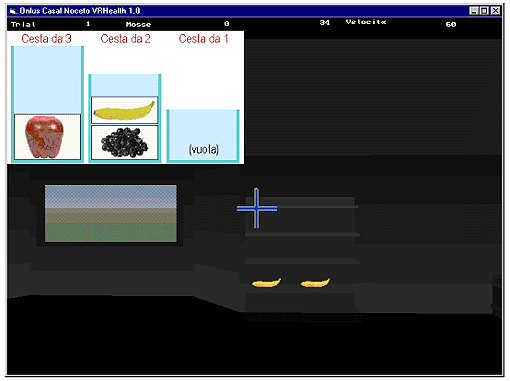
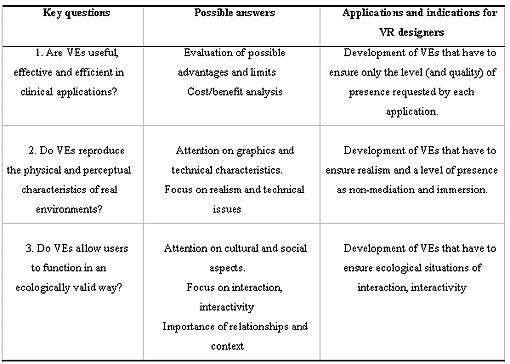
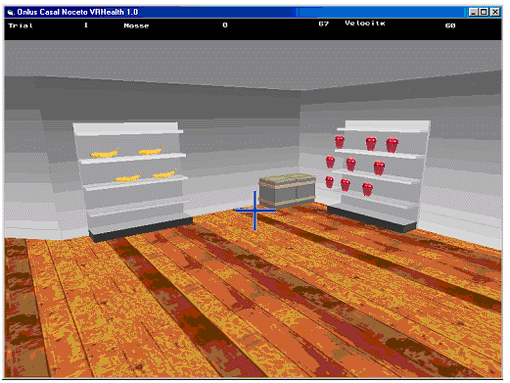
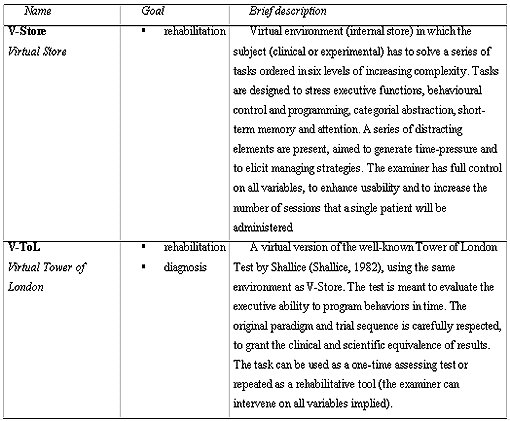
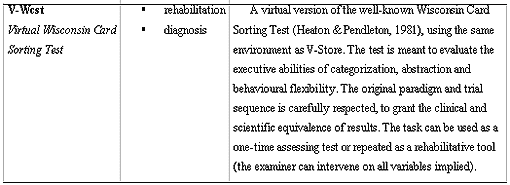
Articulos relacionados
-
Miedo a hablar en público y realidad virtual: revisión de los últimos protocolos Millán Landaluce Peña et. al
Fecha Publicación: 18/05/2025-
Cognición social en esquizofrenia Nora Ines Muros Cobos et. al
Fecha Publicación: 21/05/2021-
Uso de Realidad Virtual en la práctica clínica Begoña Albalat
Fecha Publicación: 24/05/2020-
El uso de la Realidad Virtual para entrenar Mindfulness: ¿Qué nos dice la investigación? Marta Modrego Alarcón et. al
Fecha Publicación: 01/04/2019-
AVANCES EN LA INTERVENCIÓN SOBRE EL TRASTORNO POR DÉFICIT DE ATENCIÓN E HIPERACTIVIDAD (TDAH): NUEVAS TECNOLOGÍAS EN LA REHABILITACIÓN NEUROPSICOLÓGICA Noelia Gilibert Sánchez
Fecha Publicación: 02/05/2018-
Uso de las nuevas tecnologías en la intervención neuropsicológica en demencias. Lucía Vázquez Caxide
Fecha Publicación: 14/12/2013
-
-
-
-
-


